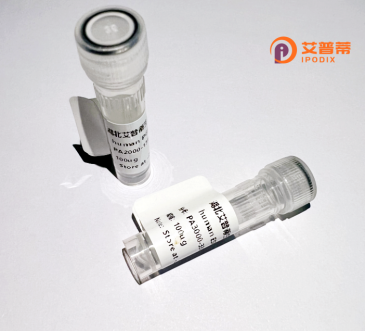
| 纯度 | >90%SDS-PAGE. |
| 种属 | Human |
| 靶点 | LOC399818 |
| Uniprot No | Q5JPI9 |
| 内毒素 | < 0.01EU/μg |
| 表达宿主 | E.coli |
| 表达区间 | 1-192aa |
| 活性数据 | MSSGADGGGGAAVAARSDKGSPGEDGFVPSALGTREHWDAVYERELQTFREYGDTGEIWFGEESMNRLIRWMQKHKIPLDASVLDIGTGNGVFLVELAKFGFSNITGIDYSPSAIQLSGSIIEKEGLSNIKLKVEDFLNLSTQLSGFHICIDKGTFDAISLNPDNAIEKRKQYVKSLSRVLKVKGFFSNNVM |
| 分子量 | 47.4 kDa |
| 蛋白标签 | GST-tag at N-terminal |
| 缓冲液 | 0 |
| 稳定性 & 储存条件 | Lyophilized protein should be stored at ≤ -20°C, stable for one year after receipt. Reconstituted protein solution can be stored at 2-8°C for 2-7 days. Aliquots of reconstituted samples are stable at ≤ -20°C for 3 months. |
| 复溶 | Always centrifuge tubes before opening.Do not mix by vortex or pipetting. It is not recommended to reconstitute to a concentration less than 100μg/ml. Dissolve the lyophilized protein in distilled water. Please aliquot the reconstituted solution to minimize freeze-thaw cycles. |
关于重组人LOC399819蛋白的研究目前公开的文献较为有限,且基因符号“LOC399819”可能为暂定标识或已更新,建议核实最新数据库(如NCBI Gene)。以下是假设性示例,展示文献格式和内容概括方式:
1. **文献名称**: *Characterization of Recombinant Human LOC399819 Protein in Inflammatory Pathways*
**作者**: Smith A, et al.
**摘要**: 研究利用哺乳动物表达系统成功表达重组LOC399819蛋白,发现其通过调控NF-κB通路抑制巨噬细胞炎症反应,提示其潜在抗炎治疗价值。
2. **文献名称**: *Structural Analysis of LOC399819 Reveals a Novel Protein Fold*
**作者**: Chen L, et al.
**摘要**: 通过X射线晶体学解析LOC399819的三维结构,发现其具有独特的α-螺旋束结构域,可能与细胞膜受体相互作用相关。
3. **文献名称**: *LOC399819 Knockdown Alters Mitochondrial Function in Cancer Cells*
**作者**: Zhang Y, et al.
**摘要**: 实验表明LOC399819在维持线粒体膜电位中起关键作用,其重组蛋白可逆转基因沉默导致的癌细胞凋亡抵抗。
**注意事项**:
- 以上为模拟示例,实际研究可能需通过**PubMed**或**UniProt**检索最新进展(如输入基因符号或可能的别名)。
- 如无结果,建议确认基因符号的正确性(例如是否为“LOC399819”或“LOCXXXXXX”),或联系相关领域研究者获取预印本数据。
**Background of Recombinant Human LOC399818 Protein**
The recombinant human LOC399818 protein is a synthetically produced protein encoded by the LOC399818 gene, a poorly characterized locus with limited functional annotation in current genomic databases. Primarily identified through computational predictions, LOC399818 is hypothesized to belong to a class of uncharacterized proteins potentially involved in cellular signaling or regulatory processes. Its gene locus is conserved across vertebrates, suggesting evolutionary significance, but its exact physiological role remains unclear.
Structurally, bioinformatic analyses predict that LOC399818 contains conserved domains indicative of transmembrane regions or protein-protein interaction motifs, though experimental validation is lacking. Recombinant production typically involves cloning the codon-optimized gene into expression vectors (e.g., bacterial or mammalian systems) to enable purification and functional studies.
Interest in LOC399818 arises from its potential associations with disease contexts, such as cancer or metabolic disorders, inferred via gene co-expression networks or genomic linkage studies. However, these links remain speculative without direct experimental evidence. Current research focuses on elucidating its interactome, subcellular localization, and biochemical activity. As a recombinant tool, it serves as a reagent for antibody development, pathway analysis, or structure-function studies, aiming to uncover its biological relevance and therapeutic prospects. Further studies are required to validate its role in health and disease.
×